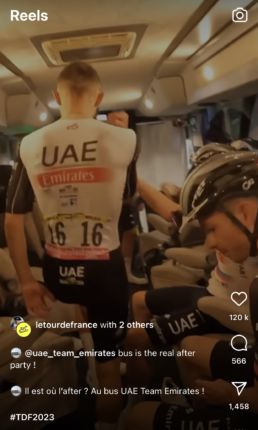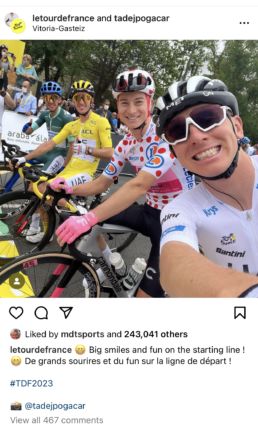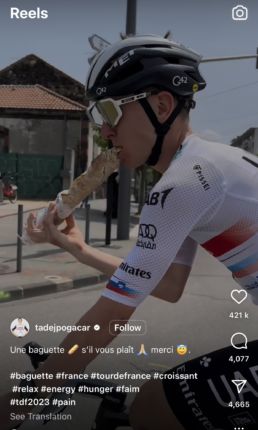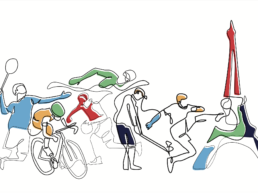Published: 31 July 2023
Cycling is experiencing something of a renaissance.
Approximately 469.5 million people now cycle worldwide, 4% more than last year.
While interest in riding bikes won’t always translate into interest in the elite stuff, the success of Netflix’s ‘Unchained’ documentary – which featured in the platform’s top 10 streamed list in its first full week with 1.5m views – demonstrates the clear appetite for elite cycling and served as the perfect amuse bouche for this year’s Tour.
The question is: does the current buzz translate into success on social media?
Enter #SportOnSocial Tour de France 2023 League Table – our annual report that ranks teams based on their social media performance.
What’s more, for the first time ever, we’ve analysed the performance of riders, as well as providing the usual mix of trends, insights and takeaways.
So, while it’s harder than ever for sport to stay relevant, the world of pro cycling has reasons to be optimistic, as the report highlights.
Team engagements (+43%), video views (+75%), and follower growth (+55%) are all up on the 2022 Tour despite them having shared 15% fewer posts. The 13.2 million engagements on Instagram and 39.7 million video views on TikTok were record highs.
Enjoy the findings and, in the meantime, here are 3 quick marketing principles (and a personal titbit) that pro cycling can apply on social media to help capitalise on the overall cycling buzz.
1. Don’t obsess over targeting
If the current Barbie phenomenon has taught us anything, it’s the benefit of being everywhere (and having massive marketing budgets).
That’s not to say you shouldn’t target specific audiences with specific content – you should. But don’t obsess. One of cycling’s key goals on social media is to be seen by as many people as possible.
That’s why ‘reach’ is such a good metric of social media success. Look at it as much more than a vanity metric: as long as your content is being seen for long enough for your brand to be remembered, it’s the first building block to a strong brand identity.
This year’s Tour de France (TDF) generated huge search interest and managed to penetrate new markets effectively as fans from around the world showed interest in their national stars. Search interest in Costa Rica, for example, was up 81% as the country’s rider Andrey Amador made his return following a year where it had no representation at all.
This visibility subsequently led to huge growth, with TDF accounts generating 1.1m new followers – a 222% increase vs 2022.
2. Embrace your distinctive brand assets
Using the Barbie analogy again, what springs to mind when you think about Barbie? Pink, pink, and more pink. It’s the perfect example of a distinctive brand asset (DBA) (see the superb Jenni Romaniuk for more on this subject).
The team behind Barbie know this. It’s not complicated, and they used it … everywhere … over and over again.
So … what are the distinctive brand assets of your pro team, brand or event? And it doesn’t have to be a colour; DBAs include fonts (think Nando’s), jingles (think McDonald’s), slogans (think Nike), etc. Basically, anything that’s distinctive to your brand.
Be very clear on what your DBA is, use it constantly and consistently, and stick with it. You may get bored of it but don’t forget: you are not your audience.
What’s the best example from the world of pro cycling? Why not go up to someone and ask them ‘what sport has the yellow jersey?’.
Linking back to the TDF again, Team Jumbo–Visma was the most successful team on social media, generating a whopping 5.0m engagements and 2.5m video views.
They’re also a super example of a cycling team which has a DBA – yellow – and one that uses it in the same way at all times across social.
3. Beware of shiny object syndrome
Social media continues to evolve at an alarming pace.
New platforms, trends, egos and personalities seem to pop up on a daily basis. In fact, a quick google search puts the total number of social platforms anywhere between 100 and 150.
What channels should the world of pro cycling actually be on? Well, always go back to a fundamental principle of marketing: listen to your audience.
Who are they? Where are they? Why would they want to listen to anything you have to say?
Try this: go through the 100+ social media channels, and for each one ask: Why are we on this? as well as Why are we not on this?
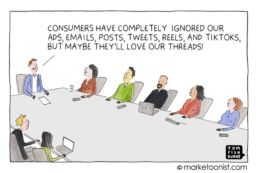
As Clara Murray, data journalist for Raconteur’s online editorial team, puts it (thanks to the brilliant Tom Fishburne for bringing this to our attention): ‘Social networks, to be of any use at all, need to be a place where people actively choose to spend time and not just a forum for advertisers.’
4. Have fun
How lucky we are to work in an industry where incredible stories so often write themselves.
This year’s TDF was filled with an abundance of great moments – from the epic battle between Meeus and Vingegaard in the final stage to incredible team comradery such as parties on buses and selfies at the starting line. It’s no coincidence that this content was also the best performing. Over half (56%) of the top 50 most engaged with posts across all channels (from team/TDF accounts) contained non-racing-specific content.
It’s really important to remember that social media is just one tactic within the wider context of the 4 Ps (Price, Product, Place, Promotion) of tactical execution that follow strategy and begin with diagnosis.
Although it’s becoming more difficult for sports to stay relevant, and the harsh truth is that most people won’t see what you do anyway, don’t beat yourself up, be creatively brave –have fun!
And finally, there’s a word not often used in social media circles: luck. Sometimes you just need to have a stroke of luck, and when you do make sure you enjoy the ride.
Alex Ross
I'm a sport-obsessed film lover with a passion for evidence-based marketing. I'm proud to own an agency that's become one of the most trusted in world sport.
My most memorable sporting moment is …
Spectating: Liverpool beating AC Milan in 2005 to win the UEFA Champions League.
I am happiest when …
With family.
The sports person that best represents me is …
Frederik Fetterlein (Danish Tennis player... worth a google).
The three things at the top of my bucket list are …
1. Complete an Ironman for the charity MIND
2. Learn a (new) language
3. Work with the NFL
A quote I try to live my life by is …
"Life is as good as the memories you make."


